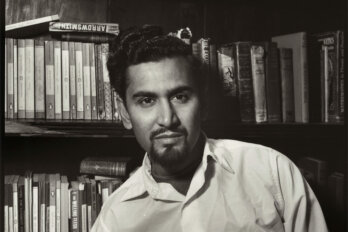The central tension that underlies good parody exists between fidelity and innovation. Balancing these elements constitutes a kind of alchemy, hitting a sweet spot that is just reverent enough to the source material before knocking it down.
Douglas Coupland’s latest book, Highly Inappropriate Tales for Young People, is ostensibly a parody of children’s stories. Accompanied by Graham Roumieu’s illustrations and written in the vein of Edward Gorey’s The Gashlycrumb Tinies, Coupland’s collection is a warped take on contemporary childhood, in which the most inauspicious characters—or inanimate objects—pose peril to rosy-cheeked naifs. Consider “Sandra, the Truly Dreadful Babysitter.” A teen with a chip on her shoulder, she frames her charges for arson and leaves them to catch pneumonia in cemeteries. Or take “Cindy, the Terrible Role Model,” a Barbie-like doll whose sole mission is to disintegrate her young owner’s self-esteem. There are also stories about “Donald, the Incredibly Hostile Juice Box,” who orchestrates the grisly murders of other juice boxes; and “Brandon the Action Figure with Issues,” a homeless war vet who is six inches tall and made of plastic.
The problem with these stories is that they fail the litmus test of parody: they’re neither imitative nor innovative. Sandra’s tale, for instance, neglects to spoof the tradition of the sugar-dispensing nannies of yore, like Mary Poppins (one nod, an illustration of Sandra flying away with an umbrella, feels like an afterthought); while Cindy’s fable misses the opportunity to riff on the Pollyanna optimism of other doll-come-to-life stories. The tales fizzle out with no consequences: after kidnapping a boy, Brandon just lets him go. Donald, having killed one too many juice boxes, is just politely asked to leave the school, and does. Unlike Gorey’s brilliant jabs at Victorian cautionary tales, Coupland’s collection lacks the precision of good satire. With no specific target, it is a ramshackle pastiche of kidlit tropes.
Thematically, though, Highly Inappropriate Tales is representative of Coupland’s work, sharing more DNA with Generation X: Tales for an Accelerated Culture than with Thomas the Tank Engine. He afflicts such characters as Sandra, Cindy, and Donald with the same anomie and ennui suffered by any of his other creations, while the choice of form illustrates another of the writer’s preoccupations: nostalgia. Coupland’s relationship with the concept has always been fraught. In his early career, he mocked its inherent artifice, coining the phrases “legislated nostalgia” (forcing constructed memories onto a group of people) and “ultra short-term nostalgia” (a wistfulness for the very recent past). But despite his vocal criticism, Coupland’s characters—apathetic, disenfranchised lost souls—have always seemingly harboured wistful longings to rekindle their ties with the world and with each other.
In recent years, Coupland appears to be grasping at those straws himself. In 2005, at the Canadian Centre for Architecture, he crafted a futuristic urban landscape inspired by a toy set from his childhood called Super City, an idealized meditation on memory and the future. Meanwhile, in the 2006 documentary Souvenir of Canada, he creates a simulacrum of Canadian identity, an installation in a soon-to-be-demolished 1970s Vancouver house (not unlike the one he grew up in) filled with memorabilia, from a hoser beer bottle collection to lumberjack plaid upholstery. In the film, he waxes nostalgic about pre-nostalgia, or longing for things that haven’t yet disappeared. “You know you’re going to miss it when it’s gone,” he says.
Highly Inappropriate Tales is the latest in a string of Generation X creations disguised as entertainment for kids but really targeted to adults. This is nothing new; the macabre tales of Gorey, of course, come to mind, not to mention those of Neil Gaiman, and Daniel Handler (a.k.a. Lemony Snicket). In film, this approach was subtle at first. Jokes soared over children’s heads in 1992’s Aladdin, as Robin Williams’ Genie hammed it up with Ed Sullivan and Jack Nicholson impressions, while Shrek spoofed The Dating Game. Then Gen X put its own postmodern spin on the tradition. Auteurs like Spike Jonze (Where the Wild Things Are ) and Wes Anderson ( Fantastic Mr. Fox ) made films that were marketed as kids’ movies but were essentially celluloid shoegaze—dreary, meditative elegies mourning the filmmakers’ lost childhoods.
The trend has gone so far as to shut out kids altogether: last spring, Adam Mansbach’s book Go the Fuck to Sleep exploded into the stratosphere, aping the lilting cadence of Margaret Wise Brown’s Goodnight Moon but tapping into a very different sentiment. Mansbach repurposes the crepuscular twilight of Moon, appealing to an exhausted faction of parents combatting children who refuse to go to bed. (“I know you’re not thirsty. That’s bullshit. Stop lying,” the exasperated father tells his wide-awake offspring.)
“Nostalgia is a weapon,” Coupland writes in Generation X, referring to the function it had acquired in response to a rapidly changing consumer culture: as a defensive tool used to idealize the past. As these authors cross the threshold into middle age (Coupland turns fifty in December), their nostalgic longings take on a new urgency, being used to cling to their childhoods and stave off the natural progression of time. Adults want in on the world of kidlit—but is there room for them?
The golden age of children’s literature took hold in the nineteenth century: Hans Christian Andersen and the Brothers Grimm assembled their fairy tales; Lewis Carroll and L. Frank Baum, respectively, conjured Alice’s Adventures in Wonderland and The Wonderful Wizard of Oz ; and, in perhaps the most romanticized depiction of childhood, J. M. Barrie created Peter Pan, the boy who would never grow up. But while we think of children’s literature as being for, well, children, these earlier examples harboured no such limitations.
Literary theorists refer to the concept of the “implied reader,” an imagined construct who possesses all the necessary predispositions for a work to have the desired effect. The implied reader is as much a part of the story as the words themselves; she is inscribed into the very act of writing. In much contemporary children’s literature, that means simplified prose and narrative: in theory, the child couldn’t appreciate irony and abstraction, so those elements are excised from the work.
But in the nineteenth century, literature had more than one implied reader, what Australian author and critic Barbara Wall calls a “double address system.” Alice’s Adventures in Wonderland, for a child, was the magical story of a little girl’s exploits in a fantasy world; adult readers, however, might have been drawn in by Carroll’s clever wordplay and logic puzzles. A young reader of Charles Perrault’s classic fairy tales would be enraptured by spells and enchantments, while an adult might be compelled by the moral and political subtext. Some authors used the double address system for more duplicitous purposes: books like Peter Pan (and much current kids’ entertainment) capitalized on young readers’ ignorance, making jokes or references that were funnier because children wouldn’t understand them.
In the early twentieth century, Wall suggests, the adult was phased out completely, creating a single address system. Series like A. A. Milne’s Winnie-the-Pooh, Beatrix Potter’s Peter Rabbit, and E. B. White’s book Charlotte’s Web spoke directly to their youthful readers, betraying no consciousness or nods toward adult mediators. This trend, largely influenced by the new-found gold mine of the child as a consumer target, proliferated over the next several decades.
Children’s entertainment flourished in the twentieth century, but the post–baby boom era saw rapid sociological changes that left Gen-Xers (those born roughly between 1961 and 1981) with no childhood of their own. In their 1997 book, The Fourth Turning, An American Prophecy: What the Cycles of History Tell Us about America’s Next Rendezvous with Destiny, historians William Strauss and Neil Howe suggest that the childhood of Gen X was, for the most part, an abandoned one. They wrote of a “new society-wide hostility toward children” bolstered by the advent of birth control, feminism, and a spate of pop culture in which children were demonized: Rosemary’s Baby, The Exorcist, The Omen.
Divorced, absent parents, meanwhile, basically left children to raise themselves, leading to a generation of latchkey kids who were reared more by child-friendly, self-esteem-boosting pop culture like Sesame Street and Free to Be… You and Me than by their own mothers and fathers. Judy Blume’s Are You There God? It’s Me, Margaret ushered them through puberty; and in novels like E. L. Konigsburg’s From the Mixed-Up Files of Mrs. Basil E. Frankweiler and Norton Juster’s The Phantom Tollbooth, they met their contemporaries: other abandoned kids, bored of their humdrum lives, who find themselves venturing alone into the world. It is no wonder, then, that Gen-Xers are now trying to ride the coattails of their own kids’ childhoods.
Coupland’s book serves as one of many attempts by a lost generation to recapture its misspent youth, but it is complicated by a refusal to give up Gen X’s trademark world-weariness. With his straightforward narratives and stripped-down prose (“He decided it was time to dream—and to make that dream come true!” thinks Kevin the Hobo Minivan), Coupland has adopted the tone of children’s picture books and refashioned them to appeal to the idiosyncratic cynicism of his cohort. (For example, Cindy is a “child star who experienced way too much way too early in life.”)
But the trouble with these fractured fairy tales, winking allusions, and clever parodies is that the reader can never fully surrender to the child’s sphere of earnestness and escape. While attempting to revisit their youth, these Gen X writers are repurposing it through a lens of disenchantment, in effect shutting out the child from his own party.
This adult colonization recalls a 1990 story, “The Barnum Museum,” by the American writer Steven Millhauser, in which he describes a wondrous emporium filled with enchantments: a hall of mermaids, jarred homunculi, a flying carpet, a forest of invisible spirits. “It may be thought that the Barnum Museum is a children’s museum,” the story notes. Many parents, however, “prefer to wander the seductive halls alone, in the full freedom of adult yearning, monotony, and bliss.” Children’s literature has always been a hermeneutic Barnum Museum; it is intended for the young, but adults are unable to relinquish their grip on its magic.
While some Gen X appropriation of kids’ entertainment excludes the children, and simplistic picture books alienate the adults, other trends in readership suggest that this is not a zero-sum game. Witness the success of the Harry Potter series and other franchises, such as Philip Pullman’s His Dark Materials and Suzanne Collins’s The Hunger Games. On the subway, at the office, late at night, these books are being devoured by adult readers, and for good reason. These earnest, wink-and-nudge-free children’s works marry accessibility and complexity, and capitalize on a universal desire for escape. Perhaps these books signal a return to the double address system, in which the line between kids’ and adult literature isn't so firm, and in which the bedtime story can be equally anticipated by parent and child. Here’s to a new golden age.
This appeared in the January/February 2012 issue.






